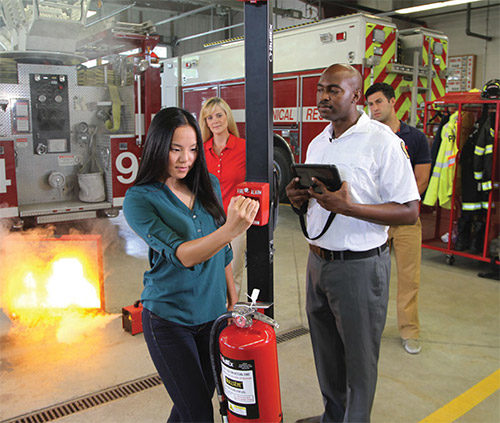Enlivening emergency education programs
My current fire prevention education program consists of a PowerPoint presentation, and I can tell my workforce is bored. How can I put life back into the program and keep people engaged?

Responding is Ryan O’Donnell, founder, BullEx, Albany, NY.
First off, let me start by congratulating you on taking the initiative to improve your fire prevention program. A surefire way to help your workforce effectively learn and remember a new safety skill is to keep them engaged.
Traditionally, hands-on training involved taking your workforce outside to practice using real extinguishers on a fire in a diesel burn pan. As anyone who has discharged a dry chemical extinguisher can tell you, this method is messy. Additionally, buying extinguishers and/or refilling them is quite costly. And depending on the weather in your area, you might encounter some resistance to an hour-long outside training. Understandably, many instructors decide to avoid the hassle by focusing on classroom training exclusively.
However, fire extinguisher training has come a long way in recent years. Now, digital systems allow you to train where your employees might actually face a fire – in the break room or on the production floor, for example. The extinguishers emit laser beams instead of chemicals, but still have the same weight, feel and discharge time as the real thing to give your students that sought-after muscle memory.
Additionally, good fire prevention programs should include what to do when you notice a fire and how and when to evacuate if you can’t or aren’t comfortable extinguishing the fire. This should also be a hands-on exercise. Take each employee through evacuation routes depending on where they are in the building. Rather than simply reciting your company’s emergency alert system, walk employees through each of the steps using the RACE acronym (Rescue, Alert, Confine, Extinguish).
 Teach your employees the company-sanctioned response by walking them through an emergency scenario. Place simulated victims in the scenario and encourage them to rescue them and/or confine the fire to keep them out of harm’s way.
Teach your employees the company-sanctioned response by walking them through an emergency scenario. Place simulated victims in the scenario and encourage them to rescue them and/or confine the fire to keep them out of harm’s way.
If there’s a fire in the break room, what doors can they close to contain the fire? Where is the nearest phone and the nearest pull station? Should they call 911? Is there another internal number they should alert? Will your employees remember to alert someone else to the fire before attempting to extinguish? What is your policy on evacuating and rescuing clients, customers, employees, etc.? Where is the appropriate extinguisher located?
By allowing workers to practice the scenarios themselves, your employees will be better prepared. Much like extinguisher training, interactive tools such as fire alarm pulls and emergency annunciators are available to help your students practice and help you track their progress.
During an emergency, we are bombarded with decisions to make, all while under extreme stress and the time constraint to act before the fire gets out of control. The best way to make sure your employees know what to do is to take them through the exact steps they need to take, in the places they need to make them. Not only will this keep them engaged and interested, it will make them better first responders.
Editor's note: This article represents the independent views of the author and should not be construed as a National Safety Council endorsement.
Post a comment to this article
Safety+Health welcomes comments that promote respectful dialogue. Please stay on topic. Comments that contain personal attacks, profanity or abusive language – or those aggressively promoting products or services – will be removed. We reserve the right to determine which comments violate our comment policy. (Anonymous comments are welcome; merely skip the “name” field in the comment box. An email address is required but will not be included with your comment.)

